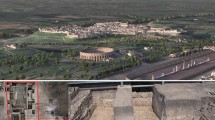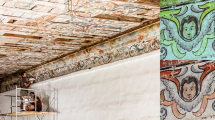Abstract
The stratigraphies of decorated walls in ancient Herculaneum, Italy, were analyzed by single-sided 1H NMR. A large version of the NMR-MOUSE® with a maximum penetration depth of 25 mm was used to map proton density profiles at different positions of the Mosaic of Neptune and Amphitrite showing considerable differences between different tesserae and the mortar bed at different times of the year. In the House of the Black Room, different mortar layers were observed on painted walls as well as different proton content in different areas due to different moisture levels and different conservation treatments. The proton density profiles of the differently treated areas indicated that one method leads to higher moisture content than the other. Untreated wall paintings from different times were profiled in a recently excavated room at the Villa of the Papyri showing two different types of mortar layer structures which identify two different techniques of preparing the walls for painting. Reflectance Fourier mid-infrared spectroscopy and in situ X-ray fluorescence measurements complemented the NMR measurements and provided additional insight into the identification of organic coatings as well as the nature of the pigments used, respectively. The information acquired nondestructively by NMR is valued for elaborating conservation strategies and for identifying different schools of craftsmen who prepared the mortar supports of the wall paintings.







Similar content being viewed by others
References
Abragam A (1961) The Principles of Nuclear Magnetism. Clarendon Press, Oxford, UK
Blümich B (2005) Essential NMR. Springer, Berlin
Ernst RR, Bodenhausen G, Wokaun A (1987) Principles of Nuclear Magnetic Resonance in One and Two Dimensions. Clarendon Press, Oxford
Eidmann G, Savelsberg R, Blümler P, Blümich B (1996) J Magn Reson A 122:104–109
Perlo J, Casanova F, Blümich B (2005) J Magn Reson 176:67–70
www.act-aachen.de, accessed June, 2010
Bümich B, Casanova F, Perlo J, Presciutti F, Anselmi C, Doherty B (2010) Accounts Chem Res 43:761–770
Proietti N, Capitani D, Lamanna R, Presciutti F, Rossi E, Segre AL (2005) J Magn Reson 177:111–117
Proietti N, Capitani D, Rossi E, Cozzolino S, Segre AL (2007) J Magn Reson 186:311–318
Blümich B, Anferova S, Sharma S, Segre AL, Federici C (2003) J Magn Reson 161:204–209
Casieri C, Bubici S, Viola I, De Luca F (2004) Solid State Nucl Magn Reson 26:65–73
Proietti N, Capitani D, Pedemonte E, Blümich B, Segre AL (2004) J Magn Reson 170:113–120
Del Federico E, Centeno SA, Kehlet C, Currier P, Stockman D, Jerschow A (2010) Anal Bioanal Chem 396:213–220
Rühli FJ, Böni T, Perlo J, Casanova F, Baias M, Egarter E, Blümich B (2007) J Cult Herit 8:257–263
Proietti N, Capitani D, Cozzolino S, Valentini M, Pedemonte E, Princi E, Vicini S, Segre AL (2006) J Phys Chem B 110:23719–23728
Sharma S, Casanova F, Wachen W, Segre AL, Blümich B (2003) Magn Reson Imag 21:249–255
Blümich B, Casanova F, Perlo J, Anferova S, Anferov V, Kremer K, Goga N, Kupferschläger K, Adams M (2005) Magn Reson Imag 23:197–201
Blümich B, Casanova F, Perlo J (2008) Prog Nucl Magn Reson Spectrosc 52:197–269
Casieri C, Senni L, Romagnoli M, Santamaria U, De Luca F (2004) J Magn Reson 171:364–372
Blümich B, Haber A, Casanova F, Del Federico E, Boardman V, Wahl G, Stilliano A, Isolani I (2010) Anal Bioanaly Chem 397:3117–3125
Conservation and management of archaeological sites. Special edition on herculaneum (2007), 8.4
Matteini M (1992) in S. Cather (Editor) The Conservation of Wall Paintings, Getty Publications, 138–148
Matteini M (1999) The mineral approach to the conservation of mural paintings. Barium hydroxide and artificial oxalates, In: Conserving the painted past: developing approaches to wall painting conservation: post prints of an international conference organized by english heritage, 110–115
Carr HY, Purcell EM (1954) Phys Rev 94:630
Meiboom S, Gill D (1958) Rev Sci Instrum 29:688
Milliani C, Rosi F, Borgia I, Benedetti P, Brunetti BG, Sgamellotti A (2007) Appl Spectrosc 61:293–299
Rosi F, Daveri A, Miliani C, Verri G, Benedetti P, Pique F, Brunetti BG, Sgamellotti A (2009) Anal Biolanal Chem 395:2097–2106
Miliani C, Rosi F, Burnstock A, Brunetti BG, Sgamellotti A (2007) Appl Phys A 89:849–856
Garcia Manzano C (2010) Characterization by XRF of the Neptune and Amphitrite Roman Mosaic at Herculaneum, Italy. Unpublished MS tesis, Hunter College, Pratt Institute
Gallagher W (2007) FTIR analysis of protein structure http://www.chem.uwec.edu/Chem455_S05/Pages/Manuals/FTIR_of_proteins.pdf, accessed January 2011
Vitruvius MP (1999) Ten Books on Architecture [De architectura libri decem]. Cambridge University Press
Donner O (1869) Die erhaltenen antiken Wandmalereien in technischer Beziehung. Breitkopf und Härtel, Leipzig
Del Federico E, Blümich B, Haber A, Garcia Manzano C, Boardman V, Souvorova D. “Non-Destructive Multianalytical characterization of Roman Polychorme Mosaics”. Manuscript in preparation
Roman Wall Paintings: Materials, Techniques, Analysis and Conservation. Proceedings of the International Workshop on Fribourg 7–9 March 1996. Editors, H. Béarat, M. Fuchs, M. Maggetti, D. Paunier
Acknowledgements
The research at Herculaneum was made possible by the assistance of Alessandra De Vita within the context of the Herculaneum Conservation Project, which is a Packard Humanities Institute project in collaboration with the Soprintendenza Speciale di Napoli e Pompei and the British School at Rome. We thank Pratt Institute’s alumna Vicki Boardman and RWTH Aachen alumnus Jörg Meyer for their assistance in this project. We thank the he Camille and Henry Dreyfus Foundation for providing the funds to purchase the portable XRF and FTIR spectrometers and to Boris Itin (from the New York Structural Biology Center) for his assistance in performing preliminary FTIR investigations for this study. EDF thanks the Pratt Institute's Faculty Development Grant.
Author information
Authors and Affiliations
Corresponding author
Electronic supplementary material
Below is the link to the electronic supplementary material.
ESM 1
(PDF 191 kb)
Rights and permissions
About this article
Cite this article
Haber, A., Blümich, B., Souvorova, D. et al. Ancient Roman wall paintings mapped nondestructively by portable NMR. Anal Bioanal Chem 401, 1441–1452 (2011). https://doi.org/10.1007/s00216-011-5180-3
Received:
Revised:
Accepted:
Published:
Issue Date:
DOI: https://doi.org/10.1007/s00216-011-5180-3




